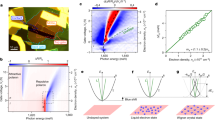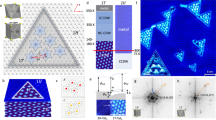Abstract
A standard exercise in elementary quantum mechanics is to describe the properties of an electron confined in a potential well. The solutions of Schrödinger's equation are electron standing waves—or ‘quantum-well’ states—characterized by the quantum number n, the number of half-wavelengths that span the well. Quantum-well states can be experimentally realized in a thin film, which confines the motion of the electrons in the direction normal to the film: for layered semiconductor quantum wells, the aforementioned quantization condition provides (with the inclusion of boundary phases) a good description of the quantum-well states. The presence of such states in layered metallic nanostructures isbelieved to underlie many intriguing phenomena, such as the oscillatory magnetic coupling of two ferromagnetic layers across anon-magnetic layer1,2 and giant magnetoresistance3. But our understanding of the properties of the quantum-well states in metallic structures is still limited. Here we report photoemission experiments that reveal the spatial variation of the quantum-well wavefunction within a thin copper film. Our results confirm an earlier proposal4 that the amplitude of electron waves confined in a metallic thin film is modulated by an envelope function (of longer wavelength), which plays a key role in determining the energetics of the quantum-well states.
This is a preview of subscription content, access via your institution
Access options
Subscribe to this journal
Receive 51 print issues and online access
$199.00 per year
only $3.90 per issue
Buy this article
- Purchase on Springer Link
- Instant access to full article PDF
Prices may be subject to local taxes which are calculated during checkout



Similar content being viewed by others
References
Grünberg, P., Schreiber, R., Pang, Y., Brodsky, M. B. & Sowers, H. Layered magnetic structures: evidence for antiferromagnetic coupling of Fe layers across Cr interlayers. Phys. Rev. Lett. 57, 2442–2445 (1986).
Parkin, S. S. P., More, N. & Roche, K. P. Oscillations in exchange coupling and magnetoresistance in metallic superlattice structures: Co/Ru, Co/Cr, and Fe/Cr. Phys. Rev. Lett. 64, 2304–2307 (1990).
Baibich, M. N. et al. Giant magnetoresistance of (001)Fe/(001)Cr magnetic superlattices. Phys. Rev. Lett. 61, 2472–2475 (1988).
Ortega, J. E. & Himpsel, F. J. Quantum well states as mediators of magnetic coupling in superlattices. Phys. Rev. Lett. 69, 844–847 (1992).
Smith, N. V., Brookes, N. B., Chang, Y. & Johnson, P. D. Quantum-well and tight-binding analyses of spin-polarized photoemission from Ag/Fe(001) overlayers. Phys. Rev. B 49, 332–338 (1994).
Kawakami, R. K. et al. Observation of the quantum well interference in magnetic nanostructures by photoemission. Phys. Rev. Lett. 80, 1754–1757 (1998).
Mankey, G. J., Willis, R. F. & Himpsel, F. J., Band structure of the magnetic fcc pseudomorphs: Ni(100), Co(100), and Fe(100). Phys. Rev. B 48, 10284–10291 (1993).
Acknowledgements
This work was supported by the US DOE, the US National Science Foundation, and the University of California for the conduct of discretionary research by Los Alamos National Laboratory. Z.D.Z. acknowledges the support of the National Science Foundation of China. E.A. acknowledges the support of the Miller Institute at the University of California, Berkeley.
Author information
Authors and Affiliations
Corresponding author
Rights and permissions
About this article
Cite this article
Kawakami, R., Rotenberg, E., Choi, H. et al. Quantum-well states in copper thin films. Nature 398, 132–134 (1999). https://doi.org/10.1038/18178
Received:
Accepted:
Issue Date:
DOI: https://doi.org/10.1038/18178
This article is cited by
-
Current-induced magnetization switching in atom-thick tungsten engineered perpendicular magnetic tunnel junctions with large tunnel magnetoresistance
Nature Communications (2018)
-
Visualizing Non-abrupt Transition of Quantum Well States at Stepped Silver Surfaces
Scientific Reports (2015)
-
Engineering the interlayer exchange coupling in magnetic trilayers
Scientific Reports (2015)
-
Quasiparticle lifetimes in metallic quantum-well nanostructures
Nature Physics (2010)
-
Probing magnetism in the well
Nature (1999)
Comments
By submitting a comment you agree to abide by our Terms and Community Guidelines. If you find something abusive or that does not comply with our terms or guidelines please flag it as inappropriate.



